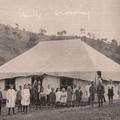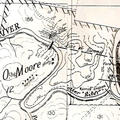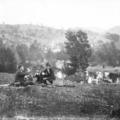< Early Canberra Government Schools
Cotter River School [1914 - 1917]
"In 1914 the Cotter River dam was under construction and a camp had been established for the workmen and their families . The nearest school was a sudsidised school at Yarralumla ('Bulgar Creek') and as there were 30 children of school age at the camp the Administrator of the Federal Territory agreed to have a marquee erected for use as a temporary school. The Cotter River Public School opened on 6th April 1914 with Sidney Marshall as teacher".
These bare facts conceal a certain amount of drama. There is a letter on file (19th May 1913) from the District Secretary of the local Branch of the Railway Workers and General Labourers Association, Tom Kinlyside, to the Minister for Home Affairs, King O'Malley, advising that 'there are fifteen children between the ages of 5 years and 12 years who would attend a school if one was established at Cotter Junction' . On 8th July that year the official count was twenty prospective pupils living within three miles, with all names and ages listed.
Eight months after his initial request, Tom Kinlyside wrote again, expressing disappointment that nothing had been done and urging action. By February, provision of schooling at the Cotter seems to have become a matter of urgency for the Federal Territory administration. On 13th February 1914 David Miller, the Administrator, wrote to the Chief Clerk, (Commonwealth) Department of Home Affairs to advise that he had sent a telegram to the Under Secretary, (NSW) Department of Education saying:
'Urgently necessary provide instruction some thirty children ages six to twelve years at Cotter River Federal Territory. Will have marquee in position within ten days. Minister desires obtain your co-operation by detailing suitable teacher and supply necessary books, maps, etc. Kindly wire when could your Officer take up duty'.
Miller continues:
"I shall be glad if you will be good enough to place the matter before the Minister with a view to the despatch of a communication through the Prime Minister to the Premier of New South Wales asking that a suitable teacher be appointed at the earliest possible moment". Such were the convoluted pathways for administering schools in the first years of operation of the Federal Territory!
According to Jones, this new found urgency was not unrelated to a major strike action that started on 30 January 1914:
"Workers laying the pipeline from the Cotter Pumping Station to Canberra were incensed when one of their colleagues, J A Ryan, was sacked for absenteeism, and 30 men went on strike. The workers thought Ryan was sacked for being an active member of the Railway Workers and General Labourers Association. They not only wanted him to be reinstated, but also demanded a school at the Cotter, which they got.....A vote for a general strike of all Canberra union members was only narrowly averted. The local member, Austin Chapman, thought the situation very serious and sought the intervention of the Prime Minister, Joseph Cook, who travelled from Melbourne and met with the striking men." (Jones p. 128)
In January of that year the Director General had recommended construction of a new building 'for thirty scholars' (Standard departmental 'D' type. Plans and specifications for a new Duntroon school 'for eighty scholars' were forwarded at the same time):
"Recommended that a school, as per drawing prepared by the Works Director for New South Wales, be approved, omitting side verandah and lavatory screen. Bench and two wash tins to be placed in hat room. Walls to be single lined. Fireplace and flue iron. I consider the of building including fittings, erected and finished consistently for the purpose of a temporary school, can be kept within ₤240".
He was persuaded however that the anticipated lifespan of the Cotter construction work did not warrant this:
'At present rate of progress the (Cotter dam and pumping station) works will be completed in about nine months, again in a few months a steady diminution in men employed will take place. I am of opinion a permanent building is not necessary - but a tent school is suggested for favourable consideration......".
This contradicted earlier advice from the Works Director for New South Wales, P T Owen:
"The Administrator mentioned canvas tents as a temporary expedient but Col. Wells (the Education Architect) advises strongly against this and recommends wood and iron as shown (plans were attached); he states that canvas has been tried and has proved a failure for schools even for temporary purposes and not really economical".
The files record that "....Minister not prepared to agree to construction of wooden building", which would have been enough to seal the matter.
A marquee was procured from the Naval College at Jervis Bay. A memorandum of 12th February 1914 from the Works Director for NSW to the Director-General of Works, Department of Home Affairs (Melbourne) describes it in the following terms:
"One marquee complete 30 feet x 16 feet, with new fly, 2 doors with hinges and locks, 2 large centre poles, and 16 small poles. With regard to the flooring, I have to state that I informed the Director-General of Works that the cost of freight on this would be more than the value of same, and suggested that a new floor should be provided at the Cotter River, this he agreed upon...... Arrangements were made with Messrs Fitzgerald Stokes and Co. to forward the material by passenger train yesterday [from Sydney to Queanbeyan] and Mr Brilliant was advised of its despatch". Seven desks were procured at a cost of ₤19-17-0, apparently especially made at Acton. A telegram from Inspector J Dawson on 27th March confirmed that Mr Sidney Marshall had been appointed teacher, and arrangements had been agreed for him to take up residence in the 'Officers Mess'.
In August 1915 the General Secretary of the NSW Railway Workers and General Labourers Association wrote to Peter Board, Under Secretary Department of Public Instruction advising that Sidney Marshall had enlisted and "the 29 children who were under his care are now left without a teacher". Before the ink was dry on this letter Mr Francis Daley was appointed to replace Marshall. Daley served for two years, leaving just before the school closed.
'The Cotter' was eventually to become a major outdoor recreation destination for Canberrans. The first excursion recorded by the Queanbeyan Age was by 27 Boy Scouts on a week long camp from 27th December 1915. As this was the Christmas holiday period they were able to use the school to stay in. (Jones, p.135)
Life at the Cotter workers' camp
"The area near the Cotter Dam was home to many, perhaps hundreds of people - men, women and children - from the time that public works commenced in the area in 1912, to the mid-1920s, when work on the Uriarra Road and the Murrumbidgee Bridge was completed. The numbers declined after 1916 when work on the Dam was largely finished. A smaller number of Pumping Station and Parks and Conservation workers continued to live in the area, especially up to the 1960s. But the early worker communities are especially important, as their efforts created the Cotter Dam, the bridges, the Pumping Station, and - often a neglected achievement - the long pipeline to Canberra.
The early workers lived in what we now would consider to be primitive conditions, but they were able to enjoy the Cotter area in its natural, almost wild state. No proper cottages were erected by the Commonwealth for labouring workmen at early construction projects at the Cotter Dam, the Kingston Powerhouse or the Yarralumla Brickworks. Areas for workmen's cottages, both married and single, were set aside close to work projects comprising blocks of 12 metres by 30 metres. Residents were each charged one shilling a week rent for the land. The workers had to purchase or scavenge for the materials for the huts and erect them themselves.
Wilfred Blacket, the Royal Commissioner on Federal Capital Administration, reporting in 1917, described the residences at the Brickworks at Yarralumla and the Powerhouse at Kingston (the description would also apply to the Cotter camps), as "rows of unsightly, inconvenient huts constructed of galvanized iron, Hessian, box boards, canvas and any other material that can be obtained cheaply. These places afford no protection from the heat of summer nor from the cold, sometimes intense cold of winter, and can hardly be dignified with the name of dwellings. They have no privacy, for there are no dividing fences or walls between them. Six water closets for each twenty huts are situated on the open ground 100 yards (90 metres) behind each row".
Married workmen at Canberra have to live under conditions almost intolerable to themselves and their families. Some workmen decided to live at Canberra or Queanbeyan and cycle to work. They were paid an extra allowance for living more than nine kilometres from their place of work. There were three main camps during the construction of the Cotter Dam and Pumping Station. There were 48 tents for single men near the Pumping Station. While the government was in the process of resuming the land on which the Pumping Station now stands, the owner, Richard Moore, was demanding rent for these tents. There was also a camp for single men on the current site of Cotter Avenue, probably partly on the hillside to avoid flooding.
The married persons' quarters were probably on the area now called Cotter Bend, close to the junction of the Cotter and the Murrumbidgee river. This area was selected to provide reasonable soil for growing vegetables. Susan Bell reports that in 1914 there were 42 women amongst the 122 adults in the camp, with 20 children attending the school, which operated from March 1914 to August 1917. "
[extract from M Jones, Cotter: Nature's gift to Canberra'
The official file for the school notes:"Federal works discontinued. Teacher withdrawn 20/8/17".
Location of the school on google earth is estimated from photographs.
Memories of a former pupil:
Extract of a letter from Winifred Bishop to Lyall Gillespie (undated):
"...........the Cotter School was canvas on a wooden frame with a wooden floor. I was there for one year. The school had one teacher. When I was there his name was Leo Daley.
My name was Winifred Elgar. I have a copy of a photo which is probably the one that you have. The tallest girl in the photo was Gladys Reynolds and I was in the photo in the middle of the younger children as I had taken them for exercises for the Inspector who was visiting the school. It was my last primary school as I was 14. The year was 1915.
The teacher lived in the Single Quarters, across the river. We lived in the married quarters, near the school. We had three tents. The Cotter River was very clear and that was the water we used. The food supplies came from Queanbeyan. We had a horse and sulky. It took rather more time than in a car to go shopping.
My father was an engineer working on the Cotter Dam. The Post Office was located on one of the farms nearby. I think the people who owned it were named Oldfield."
A grand-daughter recalls
Janice Flaherty, descendant of a Cotter pupil writes:
"My grandmother, Louisa Bland and her brother Walter are the two children second and third from the left in the photo of the tent school [below]. Their father Edward Bland worked on the dam from 1912 to 1915. My Nan and Walter sent letters and packages to Mr Marshall [teacher] after he enlisted and he sent them postcards from Egypt. After they left the Cotter they moved to Queanbeyan and Nan went to Queanbeyan Public school".
Copies of Sidney Marshall's postcards are held in our collection, with thanks to Janice Flaherty.
References
Michael Jones, Cotter: Nature's gift to Canberra. ACTEW 2009. In print and also on-line.
Ann Gugler, Ch 5, Canberra's water supply; the Cotter dam, Pumping station, bridge building and Cotter River camps (1913-1917 and c. 1922) from 'Canberra Camps, Settlements and Early Housing'
National Archives of Australia. Citation: A207,G1915/1619. Administrative papers pertaining to Cotter River, Federal Capital Territory. Digital copies can be viewed on line - click on 'View digital copy'.
Ian Warden, Canberra Times article
[NOTE: There are records of at least two other tent schools in the Capital Territory - at Ginninderra and at Thornhurst. The Thornhurst tent was acquired from the Brooks Hill railway camp when the railway workers moved on down the line to Argyle Cutting.]
Location Map
Related Photos
Teachers
- Marshall, Mr Sidney Gordon
Teacher, 04/1914 - 07/1915 - Daley, Mr Francis B
Teacher, 08/1915 - 08/1917 - Margules, Mr E.
Teacher, 1917 - 1917
NSW Government schools from 1848
- Cotter River School (external link)
< Early Canberra Government Schools
If you are able to assist our work of identifying, documenting, and celebrating the early bush schools of the Canberra region, please contact us or .





